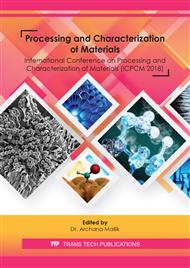[1]
N. Pragadish, M.P. Kumar, Surface characteristics analysis of dry EDMed AISI D2 steel using modified tool design. J Mech Sci Tech. 29 (2015), 1737-1743.
DOI: 10.1007/s12206-015-0347-z
Google Scholar
[2]
A. Gholipoor, H. Baseri, M.R. Shabgard, Investigation of near dry EDM compared with wet and dry EDM processes. J Mech Sci Tech. 29(2015) 2213-2218.
DOI: 10.1007/s12206-015-0441-2
Google Scholar
[3]
L. Tang, Y.T. Du, Multi-objective optimization of green electrical discharge machining Ti–6Al–4V in tap water via Grey-Taguchi method. Mater Manuf Process, 29(2014) 507-513.
DOI: 10.1080/10426914.2013.840913
Google Scholar
[4]
S.V. Kumar, M.P Kumar, Machining process parameter and surface integrity in conventional EDM and cryogenic EDM of Al–SiCp MMC. Journal of Manufacturing Processes, 20(2015) 70-78.
DOI: 10.1016/j.jmapro.2015.07.007
Google Scholar
[5]
A. Kumar, A. Mandal, A.R. Dixit, A.K. Das, Performance evaluation of Al2O3 nano powder mixed dielectric for electric discharge machining of Inconel 825. Mater Manuf Process, 33(2018) 986-995.
DOI: 10.1080/10426914.2017.1376081
Google Scholar
[6]
M. Amanullah, S.M. Islam, S.Chami, G.Ienco, Analyses of physical characteristics of vegetable oils as an alternative source to mineral oil-based dielectric fluid, In Dielectric Liquids, 2005. ICDL 2005. 2005 IEEE International Conference on 2005, 397-400. IEEE.
DOI: 10.1109/icdl.2005.1490109
Google Scholar
[7]
M. Amanullah, S.M. Islam, S. Chami G.Ienco, Evaluation of several techniques and additives to de-moisturise vegetable oils and bench mark the moisture content level of vegetable oil-based dielectric fluids In Dielectric Liquids, 2008. ICDL 2008. IEEE International Conference on (pp.1-4). IEEE.
DOI: 10.1109/icdl.2008.4622460
Google Scholar
[8]
Satish Kumar, Ashwani Kumar Dhingra, Sanjeev Kumar, Parametric optimization of powder mixed electrical discharge machining for nickel based superalloy inconel-800 using response surface methodology, Mechanics of Advanced Materials and Modern Processes 3 (2017).
DOI: 10.1186/s40759-017-0022-4
Google Scholar
[9]
K. Karunakaran, M. Chandrasekaran, Experimental Investigation Nano Particles Influence in NPMEDM to Machine Inconel 800 with Electrolyte Copper Electrode IOP Conf. Series: Materials Science and Engineering 197 (2017) 012068.
DOI: 10.1088/1757-899x/197/1/012068
Google Scholar
[10]
T.R. Paul, H.Majumder, V. Dey, P. Dutta, Study the Effect of Material Removal Rate in Die-sinking EDM for Inconel 800 using Response Surface Methodology, JMSME 9 (2015) 27-31.
Google Scholar
[11]
J.B. Valaki, P.P Rathod, C. D. Sankhavara, Investigations on technical feasibility of Jatropha curcas oil based bio dielectric fluid for sustainable electric discharge machining (EDM). J Manuf Process, 22 (2016) 151-160.
DOI: 10.1016/j.jmapro.2016.03.004
Google Scholar
[12]
P. S. Ng, S. A. Kong, S. H. Yeo, Investigation of biodiesel dielectric in sustainable electrical discharge machining. Int J Adv ManufTechnol. 90 (2017) 2549-2556.
DOI: 10.1007/s00170-016-9572-6
Google Scholar
[13]
S. Kumar, R. Singh, A. Batish, T.P. Singh, Modeling the tool wear rate in powder mixed electro-discharge machining of titanium alloys using dimensional analysis of cryogenically treated electrodes and workpiece. P I MECH ENG E J ..., 231, (2017) 271-282.
DOI: 10.1177/0954408915593875
Google Scholar
[14]
V.B. Valaki, P.P. Rathod, Investigating feasibility through performance analysis of green dielectrics for sustainable electric discharge machining. Mater Manuf Process 31(2016)541-549.
DOI: 10.1080/10426914.2015.1070430
Google Scholar


